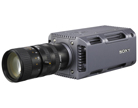XCI Series: Smart Cameras

Sony is expanding its Smart Camera lineup with the introduction of four new cameras to its XCI Series –
offering users a choice of VGA or SXGA resolution in either monochrome or color.
offering users a choice of VGA or SXGA resolution in either monochrome or color.
The XCI-SX100/XP and XCI-SX100C/XP cameras are equipped with a 1/3-type progressive scan CCD that achieves outstanding picture quality and high-resolution SXGA images (1280 x 960) at 30 fps. The XCI-V100/XP and XCI-V100C/XP employs a 1/3-type progressive scan CCD that captures clear images in VGA resolution (640 x 480) at a frame rate of up to 90 fps.
Compared to previous models, these smart cameras are equipped with enhanced processing power
(x86-compatible 1GHz, VIA Eden ULV), built-in Microsoft® Windows® XPe operating system, and a highly capable 512MB of SDRAM memory. They achieve high-speed processing with low power consumption, and also offer high-speed network operation up to 1000Base-T. In addition, these unique cameras are equipped with various interfaces, including: two USB 2.0 ports, Gigabit Ethernet I/F to enable wideband transmission, monitor output, serial interface (RS-232C), trigger input, and exposure output. They also employ Field-Programmable Gate Array (FPGA) as an additional processing device, which enables easy customization for system designers via programmable blocks.
(x86-compatible 1GHz, VIA Eden ULV), built-in Microsoft® Windows® XPe operating system, and a highly capable 512MB of SDRAM memory. They achieve high-speed processing with low power consumption, and also offer high-speed network operation up to 1000Base-T. In addition, these unique cameras are equipped with various interfaces, including: two USB 2.0 ports, Gigabit Ethernet I/F to enable wideband transmission, monitor output, serial interface (RS-232C), trigger input, and exposure output. They also employ Field-Programmable Gate Array (FPGA) as an additional processing device, which enables easy customization for system designers via programmable blocks.
And when applications call for precise color monitoring, the XCI-SX100C/XP and XCI-V100C/XP color cameras are ideal. Combining high-quality image processing within the camera, direct data transfer via a network, and the ability to control peripheral devices, these Smart Cameras offer a perfect solution for machine vision applications.
They are also an excellent choice for high-end security monitoring of parking lots, shopping centers, and train stations since they are equipped with several key surveillance features, including: support CS mount lenses, mounted Auto Iris interface, AWB, AGC, and Wide-D images. Sony’s next-generation Smart Cameras are ideal for traffic control, security, pharmaceutical, food and beverage inspection, as well as traditional machine vision applications.
Links
Looking for a reprint of this article?
From high-res PDFs to custom plaques, order your copy today!






